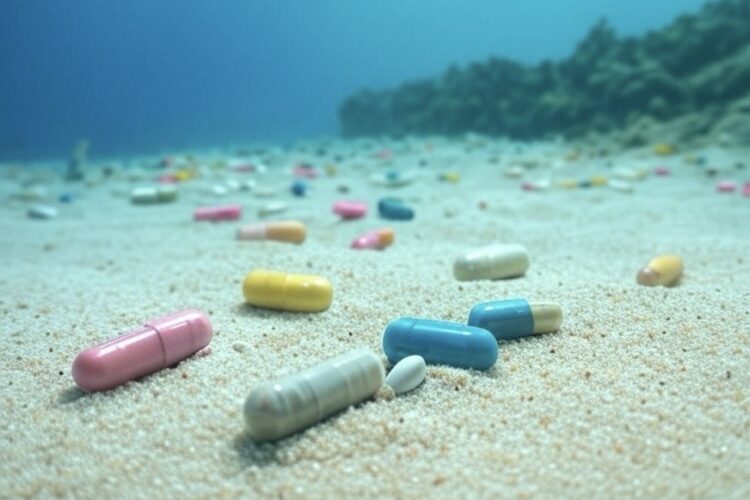Pharmaceuticals pollute oceans, harming marine life and ecosystems. Drug residues, like antibiotics and hormones, enter through wastewater, sewage, and runoff, contaminating water and accumulating in fish and shellfish. These chemicals disrupt hormones, alter fish behavior, and damage coral reefs. Microplastics worsen the issue by carrying drugs, increasing bioaccumulation. To reduce harm, we need better wastewater treatment, responsible drug disposal, and stricter aquaculture regulations. Research in ecotoxicology is vital to understand long-term effects. Protecting ocean health requires global action to limit pharmaceutical pollution and preserve biodiversity.
Long Version
The intersection of pharmaceuticals and ocean life represents a critical environmental issue that has garnered increasing attention in recent years. As marine ecosystems face growing threats from pollution, the presence of pharmaceutical contaminants in oceans has emerged as a significant concern. These chemical pollutants, including active pharmaceutical ingredients (APIs), are altering water quality, disrupting aquatic organisms, and threatening biodiversity. This article provides a comprehensive exploration of how pharmaceuticals enter marine environments, their effects on ocean health, and the broader implications for marine biology and environmental science.
The Pathway of Pharmaceuticals into Marine Environments
Pharmaceuticals enter marine ecosystems through multiple pathways, primarily as a result of human activity. Effluent discharge from wastewater treatment plants is one of the most significant sources. These facilities often lack the advanced filtration needed to remove drug residues, including antibiotics, antidepressants, hormones, and estrogenic compounds. As a result, pharmaceutical runoff from urban and agricultural areas flows into rivers, estuaries, and ultimately the oceans.
Another key contributor is sewage outfalls, where untreated or partially treated wastewater is released directly into coastal waters. Veterinary pharmaceuticals, used in aquaculture and livestock farming, also play a role, as these compounds are often excreted unchanged and enter waterways. Additionally, improper disposal of unused medications—flushed down toilets or discarded in landfills—further exacerbates water contamination.
Once in the ocean, these chemical pollutants interact with marine ecosystems in complex ways. Unlike traditional pollutants, pharmaceuticals are designed to be biologically active, meaning even trace amounts can have significant effects. The persistence of persistent organic pollutants (POPs) and the interaction of pharmaceuticals with microplastics amplify their environmental impact, creating a web of challenges for ocean health.
The Effects of Pharmaceuticals on Ocean Life
The presence of pharmaceutical contaminants in marine environments has profound effects on aquatic organisms, ranging from sublethal effects to ecosystem-wide disruptions. These impacts are studied through the lens of ecotoxicology and marine toxicology, which investigate how drug residues affect the physiology, behavior, and reproduction of marine species.
Bioaccumulation and Biomagnification
One of the most concerning phenomena is bioaccumulation, where pharmaceuticals accumulate in the tissues of aquatic organisms over time. For example, shellfish contamination has been documented, with mussels and oysters absorbing antibiotics and hormones from their environment. This accumulation can lead to biomagnification, where concentrations of chemical pollutants increase as they move up the marine food web. Predatory species, such as fish, seabirds, and marine mammals, are particularly vulnerable to high levels of drug residues.
Endocrine Disruption
Endocrine disruptors, such as estrogenic compounds found in birth control pills and hormone therapies, are especially harmful to ocean life. These compounds interfere with the hormonal systems of marine species, leading to reproductive abnormalities and developmental issues. For instance, studies have shown that fish behavior alteration—such as reduced aggression or altered mating patterns—can occur in species exposed to antidepressants or hormones. This disruption can have cascading effects on population dynamics and biodiversity.
Sublethal and Chronic Effects
Unlike acute toxicity, which causes immediate harm, many pharmaceutical contaminants exert sublethal effects that manifest over time. Chronic exposure to low levels of APIs can impair growth, immune function, and stress responses in marine species. For example, antibiotics in marine environments can disrupt microbial communities, which are critical to nutrient cycling and the health of coral reefs. Similarly, aquatic pharmacokinetics studies reveal that drug metabolism in marine species often differs from terrestrial organisms, complicating predictions of long-term impacts.
Coral Reef Degradation
Coral reef degradation is another alarming consequence of pharmaceutical pollution. Corals, which are highly sensitive to environmental changes, can suffer from altered microbial communities and reduced resilience when exposed to chemical pollutants. The combined stress of pharmaceutical runoff, microplastics, and climate change exacerbates the decline of these vital ecosystems, which support millions of marine species.
Case Studies: Real-World Impacts
Several studies highlight the tangible effects of pharmaceuticals on ocean life. In coastal regions near urban centers, sewage outfalls have been linked to elevated levels of antidepressants in fish, leading to changes in feeding and predator avoidance behaviors. In the Baltic Sea, hormones and estrogenic compounds have been detected in shellfish, raising concerns about human health risks from seafood consumption.
Aquaculture, a growing industry, also contributes to the problem. The use of veterinary pharmaceuticals in fish farming has led to localized water contamination, with antibiotics detected in sediments near fish farms. These compounds not only affect farmed species but also wild populations, disrupting the balance of marine ecosystems.
The Role of Microplastics in Amplifying Pharmaceutical Pollution
Microplastics have emerged as a critical factor in the spread of pharmaceutical contaminants. These tiny plastic particles act as carriers, binding to drug residues and transporting them across vast distances in the ocean. Marine organisms, from plankton to whales, ingest microplastics, inadvertently consuming chemical pollutants as well. This interaction amplifies bioaccumulation and increases the risk of biomagnification in the marine food web.
Research has shown that microplastics can enhance the bioavailability of pharmaceuticals, making them more likely to interact with aquatic organisms. This synergy between microplastics and pharmaceutical pollution underscores the complexity of addressing ocean health in the modern era.
Mitigation Strategies and Solutions
Addressing the impact of pharmaceuticals on ocean life requires a multifaceted approach, combining technological innovation, policy changes, and public awareness. Below are key strategies to mitigate this issue:
Improving Wastewater Treatment
Upgrading wastewater treatment facilities to include advanced filtration systems, such as activated carbon or membrane bioreactors, can significantly reduce the release of pharmaceutical contaminants. These technologies target APIs and persistent organic pollutants, preventing them from entering marine ecosystems.
Promoting Responsible Disposal
Public education campaigns can encourage proper disposal of unused medications, reducing the amount of drug residues entering waterways. Take-back programs and designated disposal sites are effective tools for minimizing pharmaceutical runoff.
Regulating Pharmaceutical Use in Aquaculture
Stricter regulations on veterinary pharmaceuticals in aquaculture can help curb water contamination. Alternatives, such as probiotics or vaccines, can reduce reliance on antibiotics and other drugs in fish farming.
Advancing Research in Ecotoxicology
Continued investment in ecotoxicology and marine toxicology is essential for understanding the long-term impacts of pharmaceutical pollution. Research into aquatic pharmacokinetics and sublethal effects will inform more effective mitigation strategies.
International Collaboration
Given the global nature of ocean health, international cooperation is critical. Agreements to monitor and reduce pharmaceutical contaminants in coastal waters can help protect marine ecosystems and preserve biodiversity.
The Broader Implications for Environmental Science
The issue of pharmaceutical pollution in marine environments extends beyond immediate ecological concerns. It raises fundamental questions about the sustainability of modern healthcare systems and their environmental footprint. Environmental science must grapple with balancing the benefits of pharmaceuticals for human health with their unintended consequences for ocean life.
Moreover, the study of pharmaceutical contaminants highlights the interconnectedness of terrestrial and marine systems. Effluent discharge from urban centers thousands of miles inland can ultimately affect coral reefs or deep-sea species, underscoring the need for a holistic approach to water quality management.
Conclusion
The impact of pharmaceuticals on ocean life is a pressing environmental challenge that demands urgent attention. From bioaccumulation and endocrine disruption to coral reef degradation and fish behavior alteration, the effects of chemical pollutants are far-reaching and complex. By addressing the root causes—such as effluent discharge, sewage outfalls, and pharmaceutical runoff—and investing in innovative solutions, we can mitigate the harm to marine ecosystems and safeguard biodiversity.
This issue serves as a reminder of our responsibility to protect ocean health for future generations. Through advances in wastewater treatment, responsible pharmaceutical use, and global cooperation, we can reduce the footprint of pharmaceutical contaminants and ensure that marine biology thrives in a cleaner, healthier environment. As research in ecotoxicology and environmental science continues to evolve, it will provide the insights needed to navigate this complex challenge and preserve the delicate balance of life beneath the waves.
Hashtags For Social Media
#PharmaceuticalPollution #OceanLife #MarineEcosystems #SaveOurOceans #DrugPollution #OceanHealth #MarineConservation #EcoAwareness #WaterPollution #ProtectMarineLife #SustainableSeas #CleanOceans #OceanEcosystem #PollutionFree #MarineBiodiversity #EcoFriendly #StopPollution #OceanCleanup #GreenSeas #SaveTheFish #HealthyOceans #EnvironmentalImpact #SeaLifeMatters #NoMorePollution #OceanAdvocacy #EcoWarrior #MarineProtection #ToxicFreeOceans #SustainabilityMatters #BluePlanet
Related Questions, Words, Phrases
what is pharmaceutical pollution in oceans | how do drugs affect ocean ecosystems | impact of pharmaceuticals on marine life | why are oceans polluted by medications | effects of drug pollution on coral reefs | how do antibiotics harm ocean animals | pharmaceutical waste in marine environments | what drugs are found in ocean water | how does medicine pollution affect fish | long-term effects of pharmaceuticals on ocean ecosystems | are pharmaceuticals killing ocean wildlife | how do painkillers impact marine species | drug residues in ocean food chains | what causes pharmaceutical pollution in seas | how do hormones in water affect marine life | effects of antidepressants on ocean creatures | pharmaceutical contamination in coastal waters | how do drugs enter ocean ecosystems | impact of veterinary drugs on marine life | are oceans polluted by birth control pills | how do pharmaceuticals disrupt marine biodiversity | drug pollution effects on shellfish | what is the role of wastewater in ocean drug pollution | how do anti-inflammatory drugs affect sea life | pharmaceutical runoff and ocean health | effects of statins on marine ecosystems | how do chemotherapy drugs impact oceans | are microplastics carrying pharmaceuticals in oceans | how does drug pollution affect seaweed | impact of pharmaceuticals on deep-sea life | how do epilepsy drugs affect marine animals | what are the sources of ocean pharmaceutical pollution | how do beta-blockers harm ocean ecosystems | effects of drug pollution on plankton | are oceans becoming toxic from pharmaceuticals | how do sleeping pills affect marine life






